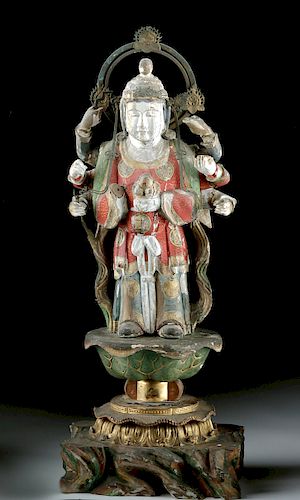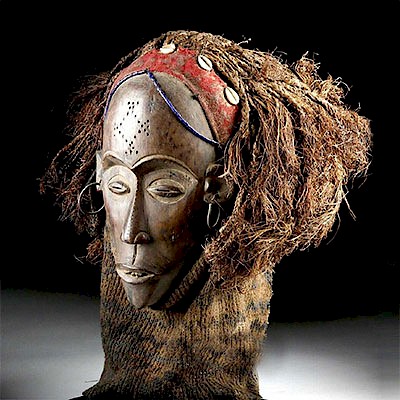Japanese Edo Period Gilt, Wood, & Bronze Bodhisattva
Lot 75b
About Seller
Artemis Fine Arts
686 S Taylor Ave, Ste 106
Louisville, CO 80027
United States
Selling antiquities, ancient and ethnographic art online since 1993, Artemis Gallery specializes in Classical Antiquities (Egyptian, Greek, Roman, Near Eastern), Asian, Pre-Columbian, African / Tribal / Oceanographic art. Our extensive inventory includes pottery, stone, metal, wood, glass and textil...Read more
Categories
Estimate:
$7,500 - $10,000
Absentee vs Live bid
Two ways to bid:
- Leave a max absentee bid and the platform will bid on your behalf up to your maximum bid during the live auction.
- Bid live during the auction and your bids will be submitted real-time to the auctioneer.
Bid Increments
| Price | Bid Increment |
|---|---|
| $0 | $25 |
| $300 | $50 |
| $1,000 | $100 |
| $2,000 | $250 |
| $5,000 | $500 |
| $10,000 | $1,000 |
| $20,000 | $2,500 |
| $50,000 | $5,000 |
| $100,000 | $10,000 |
| $200,000 | $20,000 |
About Auction
By Artemis Fine Arts
Apr 4, 2019
Set Reminder
2019-04-04 10:00:00
2019-04-04 10:00:00
America/New_York
Bidsquare
Bidsquare : Ancient / Ethnographic From Around The World
https://www.bidsquare.com/auctions/artemis-gallery/ancient-ethnographic-from-around-the-world-4003
Ancient art from Egypt, Greece, Italy and the Near East, as well as Asian, Pre-Columbian, Native American, African / Tribal / Oceanic, Spanish Colonial, Russian Icons, Fine art, much more! All categories, all price ranges... all legally acquired and guaranteed to be as described or your money back Artemis Fine Arts info@artemisgallery.com
Ancient art from Egypt, Greece, Italy and the Near East, as well as Asian, Pre-Columbian, Native American, African / Tribal / Oceanic, Spanish Colonial, Russian Icons, Fine art, much more! All categories, all price ranges... all legally acquired and guaranteed to be as described or your money back Artemis Fine Arts info@artemisgallery.com
- Lot Description
East Asia, Japan, later Edo Period, ca. 18th to early 19th century. Wow! An incredible hand-carved wood bodhisattva, Marishiten (Marishi, Marici), worshipped by Japanese warriors from the early 9th century. Here, Marishi is depicted standing atop an open lotus, which is perched on a dramatic tiered, gilded base that is made to look like a mountaintop. Marishi wears sumptuous robes, painted with circular motifs and red, blue, and green; a thick white belt hangs down the front of the garments. The bodhisattva has eight arms, two held close to the body, the other six spread outward. When originally made, this sculpture would have had a bronze implement in each of these hands, but now only two remain. A bronze openwork halo is behind Marishi's head and large headdress, which features another head. Wonderfully painted and ornate! Size: 7.75" L x 11.1" W x 27.5" H (19.7 cm x 28.2 cm x 69.8 cm)
Marishiten was the god/goddess of the warrior class, prosperity, and entertainers in Japan. They could be depicted as either male or female, sometimes with multiple heads, often with multiple arms holding weapons. The famous military leader and first shogun of the Edo period, Tokugawa Ieyasu (1542 to 1616 CE) was said to carry a small wooden Marishi charm with him at all times.
During the Edo Period, Japan was closed entirely to foreigners aside from the Dejima trading post; it enjoyed a 250 year period of economic and political stability when Japanese culture flourished with almost no inputs from abroad. Edo Period Japan creativity came mainly from the middle classes of artisans and merchants; although scholars often describe the period as secular, there were artisans who devoted themselves to creating religious art, such as shrines and wooden statues like this one. With economic stability came prosperity, and many people in Edo society were able to take pilgrimages to Buddhist shrines, encouraging religious interest and the replication of Buddhist objects in the household. This beautiful sculpture probably belonged to one of these pilgrims.
Provenance: private Hawaii, USA collection; ex-private Hawaii, USA collection
All items legal to buy/sell under U.S. Statute covering cultural patrimony Code 2600, CHAPTER 14, and are guaranteed to be as described or your money back.
A Certificate of Authenticity will accompany all winning bids.
We ship worldwide and handle all shipping in-house for your convenience.
#145115The figure and the base were made separately and it is clear where they are joined together as it is a bit loose. One of the hands is missing. Small chips, nicks, and scratches on surface, with fine remaining pigment as shown, but some areas of lost paint and gilt. Most of the bronze implements are lost, as are part of the bronze flames around the face. The bronze that remains has dark patina.Condition
- Shipping Info
-
All shipping is handled in-house for your convenience. Your invoice from Artemis Gallery will include shipping calculation instructions. If in doubt, please inquire BEFORE bidding for estimated shipping costs for individual items.
-
- Buyer's Premium



 EUR
EUR CAD
CAD AUD
AUD GBP
GBP MXN
MXN HKD
HKD CNY
CNY MYR
MYR SEK
SEK SGD
SGD CHF
CHF THB
THB














